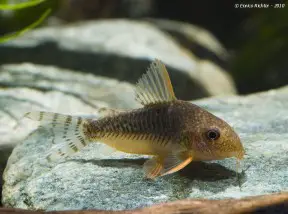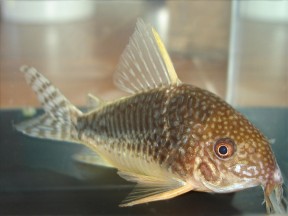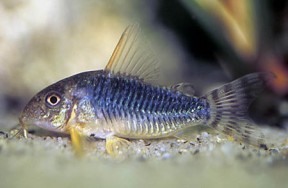Corydoras gossei
Palespotted Cory
Etymology
Corydoras: from the Ancient Greek κόρυς (korus), meaning ‘helmet’, and δορά (dora), meaning ‘skin, hide of an animal’, in allusion to the rows of bony plates on the flanks of genus members.
gossei: named in honour of Dr. J. P. Gosse, who collected the type material.
Classification
Order: Siluriformes Family: Callichthyidae
Distribution
Known only from the rio Mamoré watershed in Rondónia state, northwestern Brazil, but also likely to occur in northern Bolivia given that the Mamoré forms the border between the two countries at the type locality. The Mamoré is a major affluent within the upper rio Madeira, itself an important Amazon tributary with its confluence east of Manaus.
Type locality is ‘creek near Guajará Mirim, 10°50’S, 65°21’W, rio Mamoré system, Rondônia State, Brazil.’
Maximum Standard Length
50 – 55 mm.
Aquarium SizeTop ↑
Minimum base dimensi0ns of 90 ∗ 30 cm are recommended.
Maintenance
Ideally use a substrate of fine sand, although rounded gravel is an acceptable alternative provided that it is kept scrupulously clean.
Other décor is largely down to personal choice, but some cover should be provided to give the fish security.
Water Conditions
Temperature: 24 – 28 °C
pH: 5.5 – 7.5
Hardness: 36 – 179 ppm
Diet
Corydoras spp. are foraging omnivores, and most will accept sinking dried foods as well as small live and frozen varieties such as chironomid larvae (bloodworm), Tubifex, etc.
Feeding a varied diet will ensure the fish are in optimum condition.
Under no circumstances should they be expected to survive on ‘left-overs’ from other inhabitants of the aquarium or relied on to ‘clean’ the aquarium.
Behaviour and CompatibilityTop ↑
Peaceful and gregarious. Should be maintained in a group of at least 4-6 individuals.
Sexual Dimorphism
Females tend to grow larger, and sexually mature individuals are noticeably broader and deeper-bodied than males.
Reproduction
Can be bred in a similar fashion to many other Corydoras species.
Use a ratio of two or more males per female if possible, and when the females are visibly full of eggs perform a large (50-70%) water change with cooler water, and increase oxygenation and flow in the tank. Repeat this daily until the fish spawn.
Eggs may be deposited on the aquarium glass, among fine-leaved vegetation or within sunken spawning mops, with the latter particularly recommended since they facilitate easy removal of eggs.
Once spawning is complete either adults or eggs should be removed; the latter can usually be rolled gently up the glass with a finger. The new container should contain the same water as the spawning tank and be similarly well-oxygenated.
Most breeders add a few drops of methylene blue, or an alder cone or two at this point in order to prevent the eggs developing fungus.
Incubation is normally 3-4 days and once the fry have fully-absorbed their yolk sacs they are able to accept small live foods such as microworm, Artemia nauplii, etc.
They are not the easiest to raise, requiring excellent water quality, but seem less susceptible to ailments when maintained over a thin layer of sand rather than in a bare arrangement.
NotesTop ↑
C. gossei is also known as ‘smokey cory’ and ‘Gosse’s cory’ in the aquarium hobby.
The congener C. seussi, which is also native to the rio Mamoré, has a similar colour pattern but its snout is noticeably prolonged compared with that of C. gossei, plus there are some subtle differences in pigmentation. There is a third variant which has been referred to as ‘CW069’ in the aquarium hobby and appears to be somewhat intermediate, with a short, rounded snout as in C. gossei but a colour pattern more reminiscent of C. seussi.
The existence of multiple, similarly-coloured species which coexist and form large mixed schools is relatively common in the genus. In some cases Corydoras colour patterns have even evolved in other taxa, such as certain members of the genera Otocinclus, Brachyrhamdia, and Serrapinus. The reason for the success of such patterns is thought to be protection from predators in that they feature cryptic or otherwise disruptive details such as stripes, reticulations, or strongly-coloured fin spines. Similarly-patterned species may therefore have evolved to take advantage of foraging in a larger group while simultaneously adapting to exploit contrasting ecological niches. In Corydoras, this is typically expressed via differences in snout length or mouth position, for example.
The genus Corydoras is among the largest catfish groups and currently contains over 150 valid species.
It is included in the family Callichthyidae, of which members are often referred to collectively as ‘armoured’ or ‘mailed’ catfishes group due to the presence of bony plates in place of scales on the body.
Their taxonomy can be confusing, and numerous undescribed species are also thought to exist. Fish of unconfirmed identification entering the aquarium hobby are therefore typically assigned a ‘C’ or ‘CW’ number for purposes of reference and organisation.
They are facultative air breathers and possess a modified, highly vascularised intestine which has evolved to facilitate uptake of atmospheric oxygen and aid survival in oxygen-deprived environments. In the aquarium you’ll occasionally see them rising to the surface to take in gulps of air.
The stiffened pectoral-fin spines are capable of piercing human skin and a ‘sting’ can be very painful indeed, so care should be exercised when handling them.
It is thought that secretions from the axillary glands at the base of each spine may even be mildly toxic or venomous.
References
- Nijssen, H., 1972 - Netherlands Journal of Zoology 21(4): 412-433
Records of the catfish genus Corydoras from Brazil and French Guiana with descriptions of eight new species (Pisces, Siluriformes, Callichthyidae). - Reis, R. E., S. O. Kullander and C. J. Ferraris, Jr. (eds), 2003 - EDIPUCRS, Porto Alegre: i-xi + 1-729
Check list of the freshwater fishes of South and Central America. CLOFFSCA. - Alexandrou, M. A., C. Oliveira, M. Maillard, R. A. R. McGill, J. Newton, S. Creer, and M. I. Taylor, 2011 - Nature 469: 84-89
Competition and phylogeny determine community structure in Müllerian co-mimics. - Ferraris, C. J., Jr., 2007 - Zootaxa 1418: 1-628
Checklist of catfishes, recent and fossil (Osteichthyes: Siluriformes), and catalogue of siluriform primary types. - Fuller, I. A. M., and H-G. Evers, 2005 - Verlag A. C. S. GmbH: 1-384
Identifying Corydoradinae Catfish. - Nijssen, H. and I. J. H. Isbrücker, 1980 - Bijdragen tot de Dierkunde 50(1): 190-220
A review of the genus Corydoras Lacépède, 1803 (Pisces, Siluriformes, Callichthyidae).





